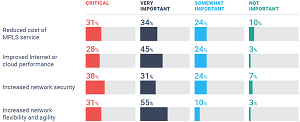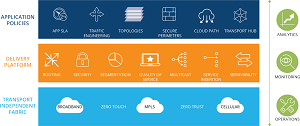News
New-Age Networking Predictions for the New Year: The Rise of SD-WANS
As software-defined networking (SDN), network functions virtualization (NFV) and other new-age networking initiatives mature, we'll be taking a look at what's in store for some of the most promising projects in the new year, starting off with a growing niche: software-defined wide-area-networks (SD-WANS).
While SDN graduated from academic exercises, proofs-of-concepts and lab trials to real-world installations and production systems, applying SDN techniques to the wide-area network (WAN) became more commonplace in 2017, a trend that's sure to continue in 2018.
According to Wikipedia, SD-WAN "simplifies the management and operation of a WAN by decoupling (separating) the networking hardware from its control mechanism. This concept is similar to how software-defined networking implements virtualization technology to improve data center management and operation."
Meanwhile a survey conducted by Tel Aviv-based Cato Networks indicated that network agility -- not lower costs or better performance -- is the deciding factor for enterprises adopting SD-WAN infrastructure.
The company said 80 percent of respondents reported increased agility and flexibility using SD-WAN, leading to one of the report's key insights: "Agility becomes the deciding factor for SD-WANs."
 [Click on image for larger view.] Ranking Priorities That Led to SD-WAN Deployments (source: Cato Networks).
[Click on image for larger view.] Ranking Priorities That Led to SD-WAN Deployments (source: Cato Networks).
"The motivation for deploying SD-WAN may have started with cost reduction and improved performance, but that's changing," the Cato Networks report said. "Agility, not cost savings, will be the mantra for tomorrow's SD-WAN. Our research shows that those considering SD-WANs are more apt to prioritize features relating to agility -- reduced deployment and configuration times -- over reduced costs."
Another company, Talari Networks, which describes itself as "the trusted SD-WAN technology and market leader," published results of another survey that showed strong interest in software-defined WANs. That interest is so strong that nearly three-quarters of the 400-plus respondents might entertain the possibility of ripping out existing Multiprotocol Label Switching (MPLS) systems with SD-WAN technology.
"The adoption of reliable enterprise networks has begun to take off at full speed as businesses are tired of their network failing over and over during mission-critical scenarios," said company exec Michele Hayes. "More and more, we are seeing SD-WAN getting placed in the same budget as the MPLS, WAN OP and Router Replacement budgets. And with nearly 75 percent of the respondents saying they would be willing to replace their MPLS for SD-WAN, IT is starting to make the necessary budget adjustments to acquire this critical technology."
Exemplifying the increased industry-wide focus on the technology, MEF, a nonprofit international industry association, last summer announced it was attempting to impose a little order on the fast-and-loose world of SDN by becoming the official steward of the growing niche of (SD-WAN) managed services.
Formerly called Metro Ethernet Forum, MEF said it's "enabling service providers to create a global ecosystem of networks that deliver agile, assured, and orchestrated services for the digital economy and hyper-connected world."
Traditional networking kingpin Cisco Systems also signified the importance of SD-WAN when it announced the acquisition of startup rival Viptela Inc. in May.
 [Click on image for larger view.] Viptela SD-WAN Architecture (source: Viptela).
[Click on image for larger view.] Viptela SD-WAN Architecture (source: Viptela).
Viptela was described as a five-year-old San Jose, Calif.-based company founded by former Cisco execs that directly competed with Cisco with its SD-WAN overlay architecture for applying SDN techniques to wide-area networks that connect enterprise branch locations.
Cisco exec Rob Salvagno emphasized the cloud-ready nature of Viptela's SD-WAN offering in a blog post.
"Since 2012, Viptela has been developing solutions to help customers anticipate and manage branch connectivity across their networks," Salvagno said. "Their cloud-first approach to SD-WAN includes cloud orchestration and management of branch networks, as well as overlay technologies. Customers can centrally manage the WAN with a real-time dashboard view to monitor the health of their network and improve connectivity."
The new Viptela technology joined the networking giant's other SD-WAN offerings: Cisco Intelligent WAN (IWAN) and Meraki SD-WAN.
With an increased focus from industry nonprofits, networking powerhouses and startups alike, SD-WAN is promising to be among the most active areas of networking innovation in 2018.
LightRiver Technologies certainly believes that, according to its own predictions post published last fall.
"As we look into 2018, one technology that will drive networks is SD-WAN," the company said. "Having its roots in Software-Defined Networking (SDN), SD-WAN provides increased network agility and reduces costs. Furthermore, SD-WAN provides the ability to manage multiple types of connections, not just one. Don’t just take our word for it, Gartner reported that SD-WAN is expected to become a $1.3 billion market by 2020."
Other Predictions:
About the Author
David Ramel is an editor and writer at Converge 360.